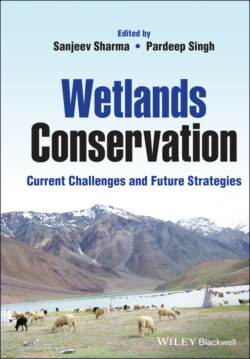Читать книгу Wetlands Conservation - Группа авторов - Страница 16
1.3 Spatial Distribution and Potential of Global Wetlands
ОглавлениеGlobally, wetlands spread from the tropics to the tundra region across all climatic zones and are the most productive and vital habitats (Mitsch and Gosselink 1993). The spatial distribution of global wetlands might have occurred before the establishment of human civilization. Understanding the global distribution of wetlands will help to promote our understanding of the sustainable growth of wetlands, help in improving the wetlands, and the decision‐making processes to preserve and protect this important part of the ecological system. Globally seasonal inland wetlands account for about 6% of the world's terrestrial area, and about 89% of them are unprotected (as specified by IUCN I–VI and Ramsar protected areas) and provide <40 % of the global Species (Ramsar 2001; Mitra et al. 2003; Reis 2017).
Global wetland area range from 0.54 to 21.26 million km2, and the class‐specific spatial consistency of wetlands is less than 1% (Shenget et al., 2016). Ecologically wetlands, natural or artificial, represent one of the planet's most valuable and vital parts of ecosystems and are also one of the most vulnerable and threatened natural resources. As per the Global Wetland Outlook: state of the world's wetlands and their services to people Ramsar Convention 2018, “The most recent estimate of global inland and coastal wetland area is more than 12.1 million km 2 , an area almost as large as Greenland. Of this, 54% is permanently inundated, and 46% seasonally flooded. An estimated further 5.2 million km 2 are intermittently or occasionally inundated, but this is believed to include areas of formerly converted wetlands affected by extreme storm events. Approximately 93% of wetlands are inland systems, with 7% marine and coastal – although this coastal estimate does not include a number of wetland groups, such as near shore sub tidal wetlands, which also fall under the Ramsar definition. Global wetland areas are small in comparison: wetlands occupy an estimated 0.3 million km2 and rice paddy 1.3 million km2 (Davidson et al. 2018; Davidson and Finlayson 2018). The size of the global wetlands has increased considerably since the 1980s, primarily due to advancement in remote sensing, geographical information system tools and mapping methods but there has not been an increase in the actual size of the wetlands (Davidson et al. 2018). The largest wetlands region at the continental level are distributed in (Figure 1.2) Asia (32%), North America (27%) and Latin America & Caribbean (16 %), Europe (13%), Africa (10%) and Oceania (3%) (Davidson et al. 2018).
Table 1.1 Classification of wetlands as defined by Ramsar Convention Bureau, 2010
Source: Ramsar wetland‐type classification retrieved from: https://www.environment.gov.au/water/wetlands/ramsar/wetland‐type‐classification © Department of Agriculture, Water and the Environment(Southern Australia). Licensed under CC BY 4.0.
| A ‐ Permanent shallow marine waters in most cases less than six m deep at low tide; includes sea bays and straits |
| B ‐ Marine sub‐tidal aquatic beds; includes kelp beds, sea‐grass beds, and tropical marine meadows |
| C ‐ Coral reefs |
| D ‐ Rocky marine shores; includes rocky offshore islands, sea cliffs |
| E ‐ Sand, shingle or pebble shores; includes sand bars, spits and sandy islets; includes dune systems and humid dune slacks |
| F ‐ Estuarine waters; permanent water of estuaries and estuarine systems of deltas |
| G ‐ Intertidal mud, sand or salt flats |
| H ‐ Intertidal marshes; includes salt marshes, salt meadows, saltings, raised salt marshes; includes tidal brackish and freshwater marshes |
| I ‐ Intertidal forested wetlands; includes mangrove swamps, nipah swamps and tidal freshwater swamp forests |
| J ‐ Coastal brackish/saline lagoons; brackish to saline lagoons with at least one relatively narrow connection to the sea |
| K ‐ Coastal freshwater lagoons; includes freshwater delta lagoons. Zk (a) – Karst and other subterranean hydrological systems, marine/coastal |
| L ‐ Permanent inland deltas. |
| M ‐ Permanent rivers/streams/creeks; includes waterfalls. |
| N ‐ Seasonal/intermittent/irregular rivers/streams/creeks. |
| O ‐ Permanent freshwater lakes (over 8 ha); includes large oxbow lakes. |
| P ‐ Seasonal/intermittent freshwater lakes (over 8 ha); includes floodplain lakes. |
| Q ‐ Permanent saline/brackish/alkaline lakes. |
| R ‐ Seasonal/intermittent saline/brackish/alkaline lakes and flats. |
| Sp ‐ Permanent saline/brackish/alkaline marshes/pools. |
| Ss ‐ Seasonal/intermittent saline/brackish/alkaline marshes/pools. |
| Tp ‐ Permanent freshwater marshes/pools; ponds (below 8 ha), marshes and swamps on inorganic soils; emergent vegetation water‐logged for at least most of the growing season. |
| Ts ‐ Seasonal/intermittent freshwater marshes/pools on inorganic soils; includes sloughs, potholes, seasonally flooded meadows, sedge marshes. |
| U ‐ Non‐forested peatlands; includes shrub or open bogs, swamps, fens. |
| Va ‐ Alpine wetlands; includes alpine meadows, temporary waters from snowmelt. |
| Vt ‐ Tundra wetlands; includes tundra pools, temporary waters from snowmelt. |
| W ‐ Shrub‐dominated wetlands; shrub swamps, shrub‐dominated freshwater marshes, shrub carr, alder thicket on inorganic soils. |
| Xf ‐ Freshwater, tree‐dominated wetlands; includes freshwater swamp forests, seasonally flooded forests, wooded swamps on inorganic soils. |
| Xp ‐ Forested peatlands; peat swamp forests. |
| Y ‐ Freshwater springs; oases. |
| Zg ‐Geothermal wetlands |
| Zk (b) – Karst and other subterranean hydrological systems, inland |
Figure 1.2 Regional distribution (%) of the wetland area
Source: Davidson et al. (2018) and Ramsar Convention on Wetlands; WORLD OUTLOOK, 2018 (2018). © Ramsar Convention Secretariat.
